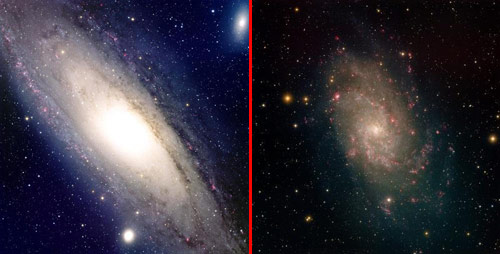The thing about black holes is, they’re black. That makes them hard to find, of course, but once you find one it’s also hard to get any information about it. The only way we can figure out anything about them is by looking at how they affect things around them: how stars orbit them, how material falls in and gives off light, and so on.
After observing many galaxies over many decades, it was found that every large galaxy has a supermassive black hole at its core, where supermassive means thousands, millions, or even billions of times the mass of the Sun. The way to weigh a black hole is to carefully measure the velocity of stars in orbit around them; the faster they move, the more massive the black hole. Thanks to Kepler, we can use those measurements to get a decent estimate of the central black hole mass.
But this can be hard to do, especially for distant galaxies. It takes long exposure times, intensive analysis, and generally quite a bit of work. But now astronomers have announced a very interesting discovery: spiral galaxies with more massive central black holes tend to have their arms more tightly wrapped. Galaxies with lower mass black holes seem to have more loosely wound spiral arms.
Why this would be is something of a mystery, and to be honest the discovery is not on absolutely firm ground. What they have uncovered is a correlation, not a rock solid cause-and-effect, but their data so far look pretty good. This idea pans out, that means that getting the mass of the central black hole in a spiral galaxy may be as easy as simply taking the galaxy’s snapshot and looking at the spiral arms. Incredibly, this means the central black hole’s mass can be determined for galaxies that are eight billion light years away!
 |
| The Andromeda (left) and Triangulum (right) galaxies. Andromeda has tight arms and a massive black hole, while Triangulum has loose arms and a lightweight black hole. Images courtesy T. Rector and B. Wolpa, NOAO/AURA/NSF, and T. Rector and M. Hanna/NRAO/AUI/NSF/NOAO/AURA, repsectively. |
So, for example, the Andromeda galaxy, which has a very massive black hole in its heart – nearly 200 million times the mass of the Sun, or about 50 times the mass of the black hole in the center of our Milky Way – has its arms relatively tightly wound up. But the Triangulum galaxy, which has loose arms, has a low-mass black hole in its core, just a few thousand times the Sun’s mass.
The mass of the central black hole turns out to be pretty important in the life of the galaxy… though probably not why you’d think. Even the most massive black hole is only a tiny fraction of the total mass of the parent galaxy – far less than even 1%! But it turns out that the mass of the black hole seems to play an important role in how the galaxy itself forms. The black hole forms at roughly the same time as the galaxy itself. As the black hole gobbles down matter, it can get what is basically indigestion, eating material too quickly. This sets up a wind of matter that blows out from the black hole, and that in turn disturbs the gas in the galaxy. That gas is what forms stars, so the star formation history of the galaxy can be affected by its central black hole. This in turn can affect how mass gets distributed in the disk of the galaxy, and that’s – maybe – why the arm structure is affected by the black hole.
However, galaxy history is fraught with danger. Galaxies collide, or slide past each other and mess each other up. This also affects how the disk and arms behave, so obviously this situation gets complicated quickly. Worse, dark matter may play a role as well, but it’s not clear how that might work either. But if the result that black hole mass somehow correlates with the spiral arm shape is correct, that will give astronomers yet another handle on how galaxies interact with the monsters at their hearts.